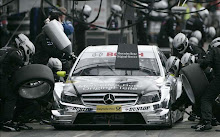 Think Formula One racing and the numbers that normally spring to mind are power outputs, top speeds and budgets. But numerically speaking there is far more than meets the eye to the average Grand Prix season. Did you know, for example, that brake discs can reach temperatures of up to 1000 degrees Celsius? Or that it takes around 40 hours to assemble a gearbox? BMW Sauber reveal some of the more surprising facts and figures from their 2008 season, as they continue to prepare for their '09 campaign...
Think Formula One racing and the numbers that normally spring to mind are power outputs, top speeds and budgets. But numerically speaking there is far more than meets the eye to the average Grand Prix season. Did you know, for example, that brake discs can reach temperatures of up to 1000 degrees Celsius? Or that it takes around 40 hours to assemble a gearbox? BMW Sauber reveal some of the more surprising facts and figures from their 2008 season, as they continue to prepare for their '09 campaign...- A driver sheds an average of two kilos in weight per Grand Prix.
- The average cockpit temperature is 50 degrees Celsius.
- A modern Formula One helmet is made of carbon and must not exceed 1,800 grams in weight, as stipulated in the regulations.
- Following the abolition of traction control, the F1.08 accelerated from 0 to 100 km/h in 2.75
seconds and from 0 to 200 km/h in 5.05 seconds. It took 0.75 seconds - equivalent to 50
metres - to brake from 300 to 200 km/h, which equates to 4.5g.
- In extreme braking manoeuvres, drivers are briefly subjected to 5g.
- Carbon brake discs and pads need a minimum operating temperature of 500–650 degrees
Celsius. During braking they hit temperatures of over 1,000 degrees Celsius.
- Some parts of the protective monocoque consist of up to 60 layers of carbon fibre. A single
carbon fibre is around six micrometres thick.
- Formula One tyres may heat up to 130 degrees Celsius. Beyond this level, there is an increased
risk of blistering.
- After a race, it takes the team at least eight working hours to dismantle the car, test and
replace individual components, and reassemble the car.
- It takes some 120 working hours to assemble the BMW engine, which consists of
approximately 1,100 different parts and around 5,000 parts in total.
- Maximum piston acceleration is 10,000 times the speed of the earth’s rotation. Peak piston
speed is 40 metres a second - or from zero to 100 km/h in 0.3 milliseconds. A force of almost
three tonnes is exerted on the conrod. The average piston speed is around 25 metres per
second.
- The exhaust reaches temperatures of up to 950 degrees Celsius.
- Over an average race distance of 300 kilometres, the BMW V8 engine undergoes around 6.5
million ignitions per Grand Prix.
- When the car comes into the pits during practice or qualifying, oil samples are taken for
immediate spectrometer analysis. Traces of metal in the oil provide important indications as to
the state of the engine.
- It takes around 40 working hours to assemble a new BMW gearbox.
- The G1.09 gearbox and associated hydraulics comprise around 1,500 parts in total, of which
480 are different components.
- About 20 gearboxes are built for test rig trials and for use in testing and races. They are
overhauled several times.
- In a gearshift process, the existing gear is released and the new one already engaged in a
matter of 0.004 seconds. It takes 50 times as long to bat an eyelid.
- High-precision bearings with ceramic rolling elements allow the shafts in the gearbox to
operate with a minimum of oil.
- The oil temperature inside the gearbox can rise to 150 degrees Celsius.
- The car’s engineer can choose from more than 50 different gear ratios when adjusting the
individual gears to a particular track.














No comments:
Post a Comment